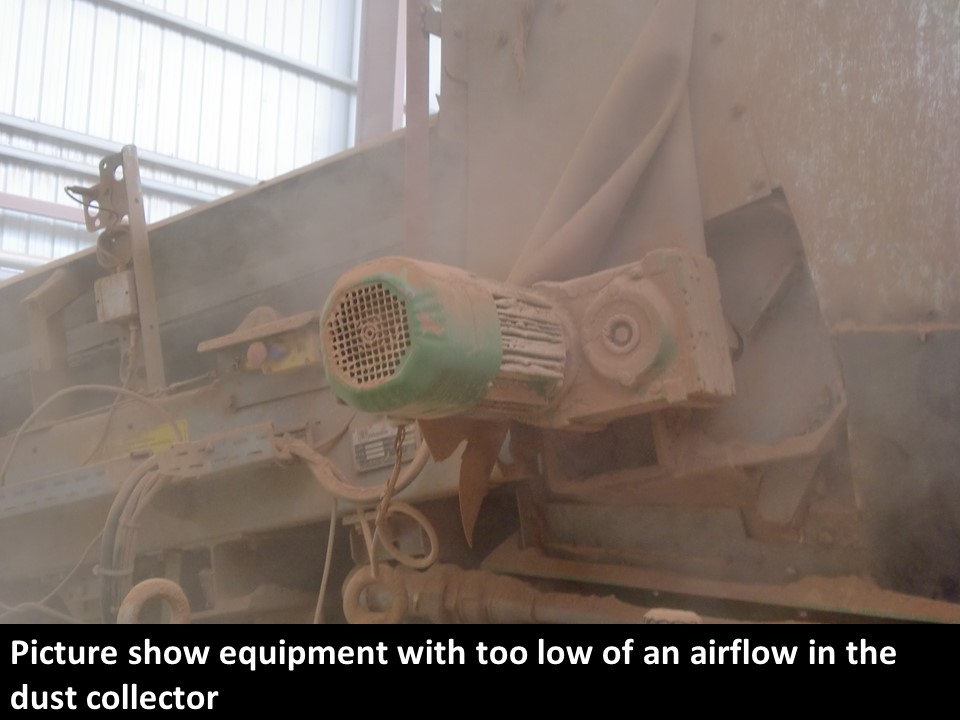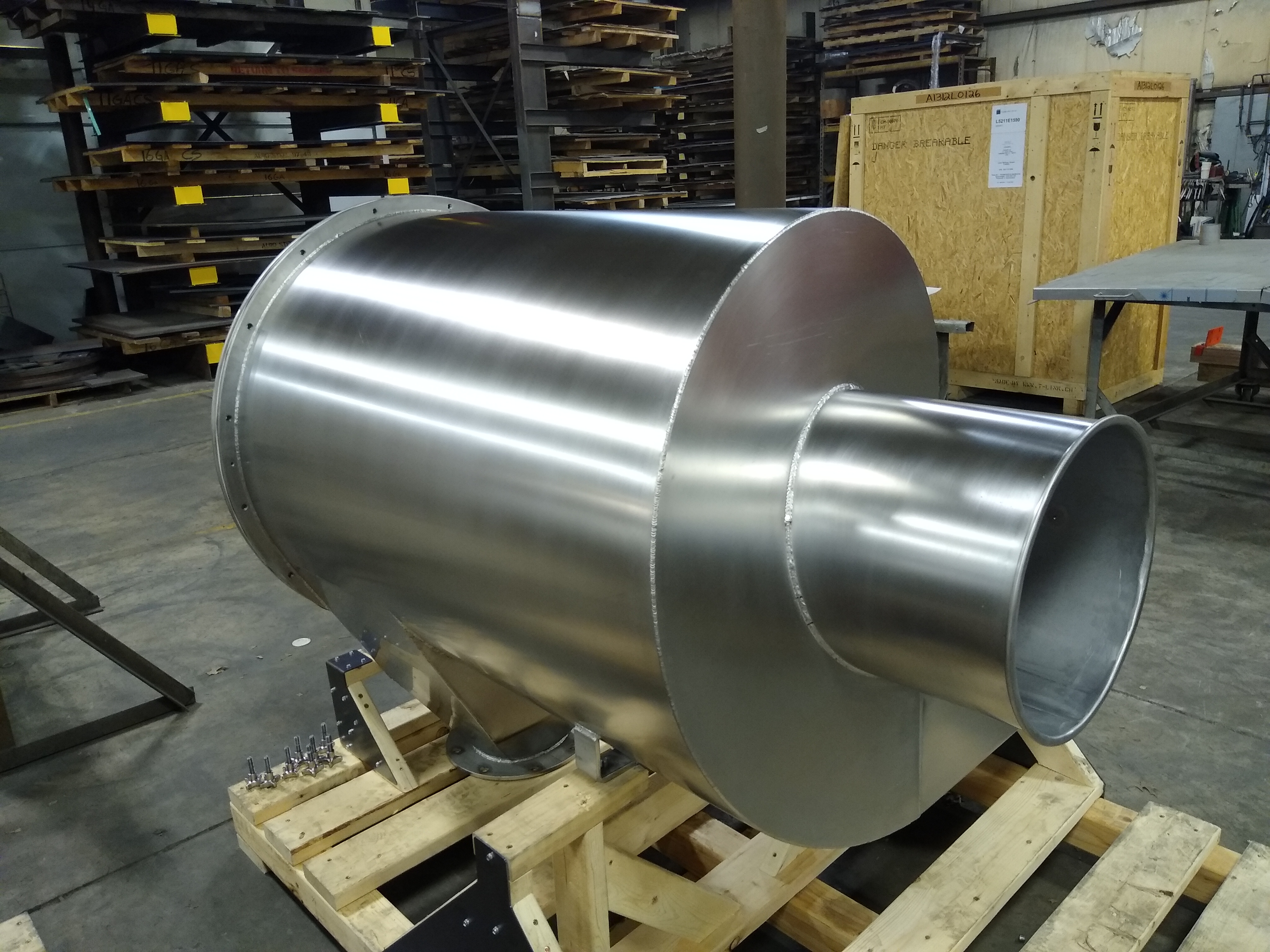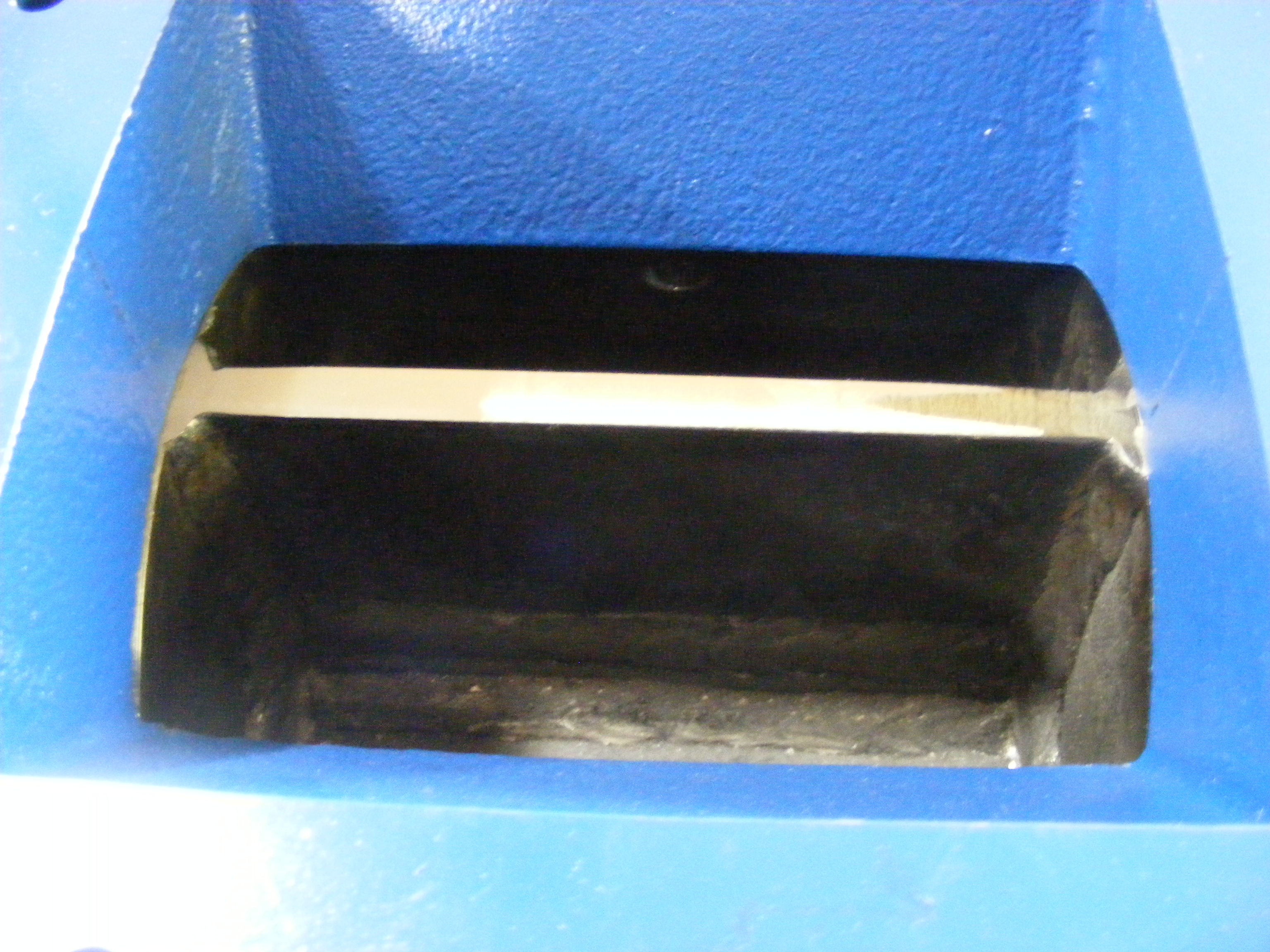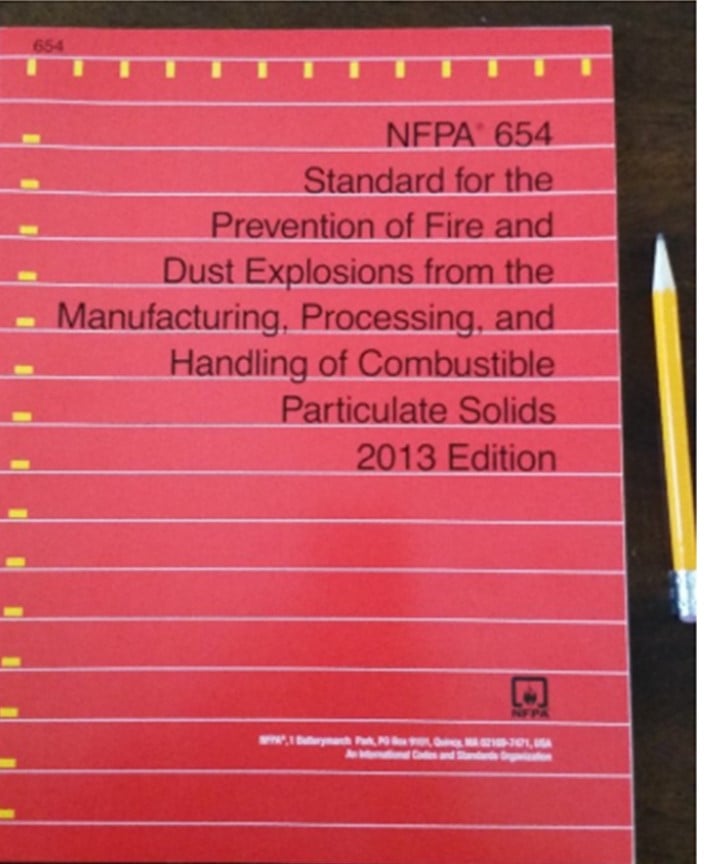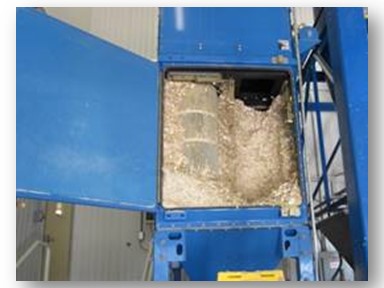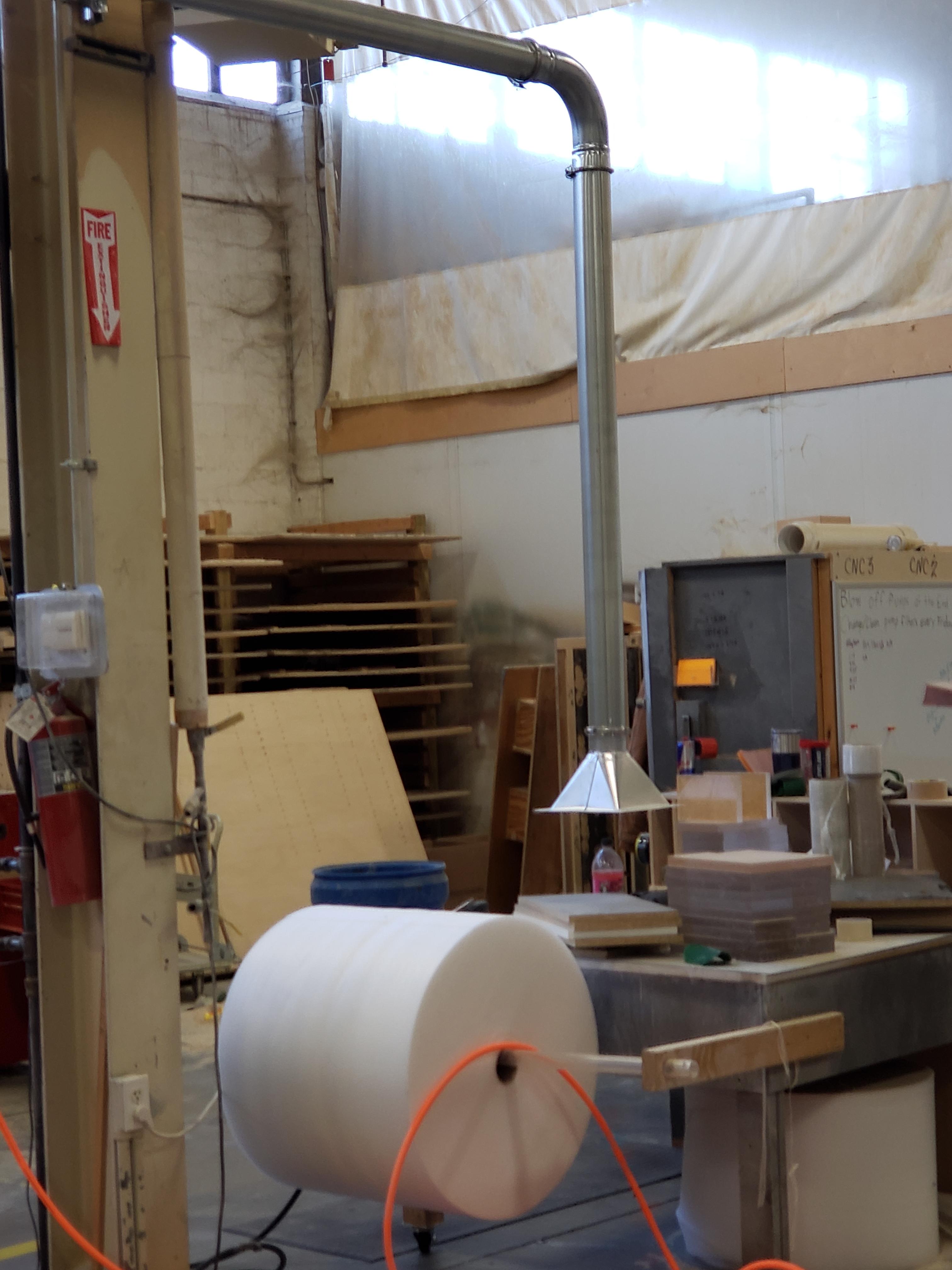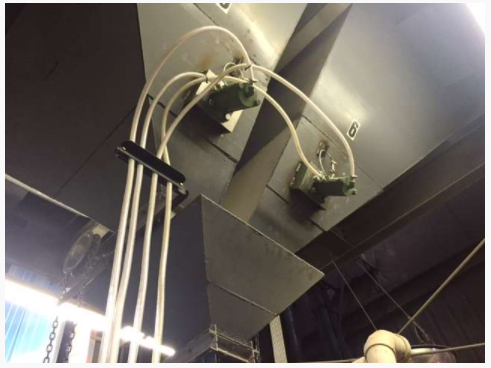- Use pulse-on-demand controller for baghouse and cartridge collectors
Pulse-on-demand controllers allow you to clean your filter less often. Less pulses helps you save compressed air and reduces wear and tear on the filters. Cutting down on compressed air means less electricity is required in the compressors and less wear and tear on the filter means they last longer. - Install a cyclone pre-filter
A cyclone pre-filter will help remove dust before it gets to your filters. This means that the dust loading on the filters will decrease, which helps extend their life by requiring less cleaning and plugging them up less. The cyclone can also allow you to recycle the material without contamination and possibly increase the total removal efficiency of the system. - Monitor airflow in the dust collection system
Dust collection systems are designed to capture dust and they should be operating at design specifications. By monitoring the airflow, you are confirming that the unit is operating correctly. If the airflow is off from its design condition, then you will not be capturing the material that it was designed to capture. Measuring the airflow is similar to measuring the temperature in an oven. Without measuring it, you won’t know if you are at the correct performance and the end result may be off. -
Install Aerodyne Vacu-Valve (if appropriate)
Topics: Cyclone Pre-Filter, vacu-valve, cleaning baghouse filter, pulse-on-demand controller
Using bags, cartridges, and filters for dust collection is one of the best ways of capturing dust particles in the airstream. The filter allows the air to pass by while preventing the particulate from passing through. The dust particles then begin to build up on the filter. This build up helps prevent smaller particles from passing through, but also makes it harder for air to pass through. Over time this dust layer will prevent the air from passing though, thereby plugging up the filters.
To prevent plugging of the filters, they are often cleaned by blowing air through them in the opposite direction of airflow. Baghouses and cartridge collectors use compressed air which expands the filter slightly so that it drops off material. The dust then falls into the hopper below. The periodic expansion of the filters will over time cause holes to form.
Dangers in Cleaning Out Filters
For HEPA filters and other inline filters, it is not as easy to clean filters during operation. Usually the filter needs to be pulled out of service and then air is blown through the filter (in the opposite way) to remove the dust from the filter. However, using high pressure air to blow out the filters can also cause holes to develop in the filter.
When these holes develop in filters, air will rush through the holes, taking dust with them. Since the holes in the media have lower resistance than the filters, air will find it easier to go through the hole than the filters. This will cause the hole to grow in size over time. And as more and more air passes through the hole, more dust will bypass the filter and contaminate the cleaned air.
Pressure Gage Is Recommended
When using filters, it is always recommended to install a differential pressure gage across the filter. As dust builds up on the filter, the differential pressure will increase. And as the pressure drop across the filter increases, less air will be flowing through the filter. So when you notice a high pressure drop across the filter, this means it is time to remove and replace or clean the filters. If you don’t replace the filter and the pressure drop decreases then it probably means that you have a hole (or holes) in your filter.
So when you are cleaning your filters, be sure to check that no holes develop. The holes can be caused by high airflow when blowing out or after repeated expansions by compressed air. The use of differential pressure gages will help you identify if a hole develops before noticing dust in the clean air. If you find that you are cleaning or replacing filters too often, installing a pre-filter such as a cyclone can lower the dust loading on the filters, thereby extending their life.
To learn more about which dust collector, please contact our experts at 440-543-7400 or visit our website: www.dustcollectorhq.com.
To improve efficiency and safety, there is no substitute for an on-site inspection by an experienced expert. Click below to start with a free 20-minute phone consultation by clicking the button.
Topics: Pressure Gages, cleaning baghouse filter, pre-filter cyclone, Dust Collector filters
The airflow in dust collection systems is crucial to the proper operation of the system. The dust collection system consists of the hood/pickup points, ductwork, dust collector(s) and exhaust fan. The hood/pickup points are designed to capture the dust. This design requires a range of airflows to properly work. If too little airflow is going through the hood, dust will escape from the hood. If too much air is going through the hood, the system can capture material it isn’t supposed to (example picking up product from the conveyor belt, not just dust lingering over the belt in the air).
The Important of Ductwork
Ductwork is like a highway for the dust in the dust collection system. It allows the airflow to be directed to the dust collector from the pickup points/hoods. The ductwork should be sized so that the airflow velocity is fast enough to keep the dust in suspension, but taking into account that the faster the airflow the higher the pressure drop is through the ductwork. The minimum velocity required to keep the dust in suspension is dependent on the dust. It can vary, but usually 4500 FPM is a safe velocity. Elbows can also increase the pressure drop of ductwork so try to minimize the elbows when designing the ductwork. Make sure you know the pressure drop in your ductwork so you can have enough static pressure in your fan to keep the design airflow.
Pressure Drop in Dust Collectors
Dust collectors have a pressure drop associated with them. Usually the higher the pressure drop the greater your removal efficiency will be, however different technologies will have different pressure drop and removal efficiencies. For example 10”WC pressure drop on a cyclone will have a lower removal efficiency than 10”WC on a filter. Be sure you have enough static pressure to operate your dust collector throughout the normal life of it. A fabric filter will build up dust on it, thereby increasing its pressure drop over time. Be sure to have enough static pressure to handle the required airflow at the point the filters are dirtiest, or else your airflow will suffer.
Exhaust Fan vs. Airflow
The exhaust fan should be designed to provide the required airflow with enough static pressure throughout the operational life of the system. This means having enough static available at the higher airflow (pressure drop increased in hood, ductwork, and dust collector) and to handle dirty filters until they are replaced (or cleaned). It is often good to slightly oversize the fan and to use a variable frequency drive (VFD) to adjust the fan as required.
Another good device is a digital airflow meter (such as Aerodyne’s GPC airflow meter) which lets you monitor the airflow through the system to be sure it is operating as it was designed.
To learn more about which dust collector, please contact our experts at 440-543-7400 or visit our website: www.dustcollectorhq.com.
To improve efficiency and safety, there is no substitute for an on-site inspection by an experienced expert. Click below to start with a free 20-minute phone consultation by clicking the button.
Topics: dust collector, cleaning baghouse filter, horizontal cyclone, GPC Cyclone, Dust Collector filters, arirflow
Material of construction is extremely important to the durability of a piece of equipment. The suitability of the materials of construction is based on the process, which includes the different components, phases, temperature, and pressure. For example: a cyclone’s material of construction would be dependent on the following:
Material (dust) Being Collected
Properties of the dust being might dictate the materials of construction. Food or pharmaceuticals will usually require stainless steel to prevent / minimize contamination. Carbon steel is often acceptable for wood applications. Other times, the material properties require a special material. For example, abrasive material might require AR steel or a coating to help prevent erosion of the cyclone.
Chemical Composition
The chemical composition of the process can dictate the materials of construction. If a component will react with the materials of construction, it could cause premature failure. For example, water or high humidity can cause rusting of carbon steel so stainless steel might be better suited. Or if an acid is a component of the gas stream, then a high alloy metal or fiberglass construction might be better suited.
Temperature and Pressure
High or low temperature can cause materials to change their properties. Material can become brittle or they may react more with components. For example fiberglass can’t handle higher temperatures whereas metals usually can. And some material might have good compatibility at lower temperatures but very poor compatibility at higher ones. Sometimes pressure can affect the material properties, but usually it will affect the thickness of the walls.
Aesthetics
Some customers have plant requirements for their equipment. For example, a food or pharmaceutical facility may require stainless steel construction even though the equipment is on the waste process and everything will be disposed of. In a similar vein, the finishing of the equipment might be determined because all the other equipment has a high polished finish and the customer wants it to fit in.
So, when determining the materials of construction, there are many factors that contribute. It is best if the end user, with help from the vendor(s), determine the materials of construction. The end user usually knows the process better than the equipment manufacturer and therefore is in the best position to determine the materials of construction.
To learn more about which dust collector, please contact our experts at 440-543-7400 or visit our website: www.dustcollectorhq.com.
To improve efficiency and safety, there is no substitute for an on-site inspection by an experienced expert. Click below to start with a free 20-minute phone consultation by clicking the button.
Topics: dust collector, cleaning baghouse filter, horizontal cyclone, GPC Cyclone, splitScream Cyclone, Dust Collector filters, arirflow
Why Does My Airlock Jam and What Can I Do About It? | Aerodyne
Rotary valves will occasionally jam. This can happen when material gets between the rotor and the housing or when oversized material cannot fit into the rotary valve pockets. Depending on the type of jamming that is happening you handle the situation differently.
Space Between Rotor and Housing
Rotary valves have a space between the rotor and the housing. This space allows the rotors to rotate freely but it can also allow air to leak across the valve. When materials falls on the rotor edge it can buildup and jam the rotary valve. So for existing rotary valves, you might have to replace or modify the existing rotor. Beveling or chamfering the rotor edges help the material to fall off the edge and into the valve pockets.
When Jams Caused by ...
For jams caused by oversized material, a valve with larger pockets is required. This could mean a larger rotary valve or replacing the rotor with a rotor containing one less pocket. Please note if the rotary valve is on an explosive application, NFPA requires a minimum of six vanes on the rotor. If these options aren’t possible, looking into a double dump valve might provide larger clearance for oversized material to pass through.
To learn more about which dust collector, please contact our experts at 440-543-7400 or visit our website: www.dustcollectorhq.com.
To improve efficiency and safety, there is no substitute for an on-site inspection by an experienced expert. Click below to start with a free 20-minute phone consultation by clicking the button.
Topics: dust collector, cleaning baghouse filter, horizontal cyclone, GPC Cyclone, splitScream Cyclone, Dust Collector filters, arirflow
How does particle size distribution affect my process explosibility?
One of the issues when figuring out if your dust is explosive is the particle size of the dust and the location where you are assessing the dust. Material that consists of very large particles sizes (larger than 500 micron) tend not to be explosive. While larger particles can catch fire, they tend to prevent explosions. However, this might not be as straight forward as you think.
Is the Process Explosive?
Let’s assume that you have a conveyor belt that feeds a grinder which then empties onto another conveyor belt which feeds a bagging station. Let’s assume that the material starts out with a particle size distribution of 10% less than 500 micron and 90% greater than 500 micron of a combustible material. After it is fed into the grinder, its target size is around 200 microns. The question is, is this process explosive? Your 1st thought would be that before the grinder, the dust is too large to be explosive, and you might want to take the material leaving the grinder and have it tested. So you test the material leaving the grinder on the conveyor and find out it isn’t explosive. Therefore you assume the whole process isn’t explosive. However, this might give you a false reading.
Is the Dust Cloud Explosive?
For example, the material falling on the conveyor belt that feeds the grinder creates a dust cloud. That dust cloud is made up of the finer particles, so it is probably made up mostly of the 10% that’s less than 500 micron. And this material could be explosive. Not only that, but if that 10% of the material particle size distribution has a significant amount of dust less than 100 micron, this could very well be the dust cloud which is much more likely to be explosive. And since the smaller the particle size the better the chance of the material being explosive, your dust cloud could be explosive dust. This would then float in the building and layer the surrounding equipment or rafters with explosive dust.
Now looking at the material leaving the grinder, even though it tested as not explosive this is the material on the conveyer or that was bagged. If the grinder feed creates a dust cloud then this will again be the finer dust. So while the majority of your material is around 200 micron, there is a small portion (now much greater than the initial amount that was less than 100 micron) that is very fine. And again, this portion of the dust is the dust that is creating the dust clouds at the exit of the grinder and in the bagging section.
So when you are collecting dust to see if it is explosive, be sure to collect the material that is pertinent. You should try to collect dust that is actually forming a cloud to make sure it is explosive and not lump it in with material that won’t form the cloud. If you have an existing baghouse or cartridge collector, use the material that is collected in the dust collector for testing.
To learn more about which dust collector, please contact our experts at 440-543-7400 or visit our website: www.dustcollectorhq.com.
To improve efficiency and safety, there is no substitute for an on-site inspection by an experienced expert. Click below to start with a free 20-minute phone consultation by clicking the button.
Topics: dust collector, cleaning baghouse filter, horizontal cyclone, GPC Cyclone, splitScream Cyclone, Dust Collector filters, arirflow
Plan Your Parts and Inspections Before Plant Shutdowns | Aerodyne
Now that it is spring, it’s time to start thinking about summer shut down! If you are planning on doing maintenance on your dust collection system now is the time to order your parts.
If you are changing bags also look into doing the following:
- Pull your airlock off and perform any needed maintenance on it (replace bearings, change out rotors or plate, replace Vacu-Valve sleeves, etc.)
- Have someone check your exhaust fan a few weeks before shutdown so that if the fan needs rebalancing or bearings replaced, you can schedule it during the shutdown.
- Inspection of your baghouse a few months before shutdown so any damage in the housing, bad air valves, tube sheet, etc. can be replaced during the process.
- Inspect the ductwork and look for holes and dust buildup. Make sure dampers are working.
- Look into installing a cyclone pre-filter to
- Increase filter life
- Decrease compressed air usage
- Collect dust before contamination in the filters
- Inspect explosion protection equipment and have any chemical isolators/suppression equipment maintained. Be sure to have the clearance of the rotary valve measured to be sure it is still in compliance with NFPA requirements.
- Schedule a Dust Efficiency Clinic to evaluate the system performance so any modifications can be installed during plant shutdown.
Doing the above will help you revitalize your dust collection system and make sure you get the best possible performance out of it.
To learn more about which dust collector, please contact our experts at 440-543-7400 or visit our website: www.dustcollectorhq.com.
To improve efficiency and safety, there is no substitute for an on-site inspection by an experienced expert. Click below to start with a free 20-minute phone consultation by clicking the button.
Topics: dust collector, cleaning baghouse filter, horizontal cyclone, GPC Cyclone, splitScream Cyclone, Dust Collector filters, arirflow
A dust collection system consists of four major components. The pickup hood, ductwork, dust collector, and exhaust fan. For the system to operate efficiently all four components much be sized and used correctly. Unfortunately, one of the main components (the hood) is often overlooked. The hood design is crucial for the operation of the dust collector system. And without the proper hood design, your dust collector will not provide the dust pickup required for the safety of the equipment and workers.
The hood should be designed so that it will capture the dust without letting dust escape. This can often be difficult as the hood will need to be designed to pull air from all the areas generating dust while also provide the required access of the operator / machine.
Using the wrong hood can cause:
- Dust to escape the hood, thereby causing health, safety, and maintenance issues.
- Too much dust is captured, removing product or components from the process.
- Too much air is used, increasing the system size and cost.
When you are looking to install a dust collector system, pay attention the hood design of the system. Spend time selecting the proper hood for the application and don’t just go with the least expensive hood, as this could cause your entire dust collection system to fail at its job.
To learn more about which dust collector, please contact our experts at 440-543-7400 or visit our website: www.dustcollectorhq.com.
To improve efficiency and safety, there is no substitute for an on-site inspection by an experienced expert. Click below to start with a free 20-minute phone consultation by clicking the button.
Topics: dust collector, cleaning baghouse filter, horizontal cyclone, GPC Cyclone, splitScream Cyclone, Dust Collector filters, arirflow
Dust collectors have hoppers under the collection chambers to channel the dust out of the system for use or disposal. The hoppers are not designed to be used to collect and store the material, but rather as a place for the material to temporarily collect before passing through the airlock and out of the system.
Dust Build-Up in Hopper
Depending on the material being collected and the characteristics of it, dust may temporarily build up in the hopper until it can pass through the airlock. Applications that have periodic high loading or applications that have materials with irregular shapes, are sticky, or hygroscopic could all build up in the hopper and form a bridge or rat hole by the dust discharge opening. When this happens, one of the most common solutions is to install a vibrator on the hopper. The vibrator works by hitting the side of the walls which can cause the material to break up and fall through the dust discharge flange and leave the system.
The Purpose of Vibrator on Hopper
Vibrators can be driven pneumatically or electronically. They also can be used to continuously agitate the hopper preventing any bridging from developing, or they can be periodically turned on to break up any bridging that has developed. When you are installing a vibrator, it is important that you let the manufacturer know how you are planning on using the vibrator so they can recommend the correct vibrator for your application.
To learn more about which dust collector, please contact our experts at 440-543-7400 or visit our website: www.dustcollectorhq.com.
To improve efficiency and safety, there is no substitute for an on-site inspection by an experienced expert. Click below to start with a free 20-minute phone consultation by clicking the button.
Topics: dust collector, cleaning baghouse filter, horizontal cyclone, GPC Cyclone, splitScream Cyclone, Dust Collector filters, arirflow
Top 5 Questions to Ask When Considering A Cyclone Dust Collector
Designing a dust collection system can be quite a daunting task. With so many collector options and so many application variables to consider, it is difficult to know where to begin. Cyclones are among the oldest and still most reliable methods of dust collection available. Because they require very little maintenance, have low up-front cost, and offer unmatched versatility, cyclone collectors remain a viable solution to many air-handling challenges. Although heightened environmental regulations and collection efficiency needs have shifted industry toward the use of filter-media collectors, cyclonic dust collection still plays a vital role in many air-handling systems. These five questions will help determine if a cyclone dust collector is right for your application.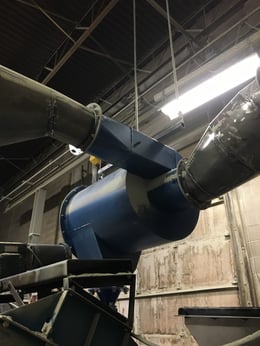
- How big is my dust?
Cyclonic dust collection relies on inertial forces to separate dust particles from an air stream. The larger and denser the particulate is, the greater its inertia. This is the reason cyclones have such high collection efficiencies when handling relatively large dust particles.
- How much dust is too much?
Grain loading or dust loading refers to the amount of dust particulate that is suspended in a gas stream. This is typically measured in the number of grains per cubic foot of gas. This is an important number to consider when designing a pollution control system. Not only will this factor into the size requirement of a dust collector, but it will also determine the appropriate type of dust collector. The strict air pollution control standards in the United States often necessitate a “filter-media” dust collector, such as a bag house, for the final collection stage.
- Can I reuse the dust I am collecting?

Dust generated by handling dry bulk materials can be hazardous but also valuable. Unfortunately, most filter-type dust collection systems are designed for disposal rather than product reclamation. Filter media collectors such as cartridge filters and bag houses often do not allow collected particulates to be recovered for reuse due to contamination or particulate size issues.
- Do I have heat or humidity concerns?
Air handling in manufacturing processes is often a delicate balance with a number of variables to contend with. Process heat and humidity in the air stream create a difficult challenge when it comes to dust collection. Collection of red-hot dust particulate is simply not possible with many bag houses because cotton filters are flammable and flame retardant filters can be costly. - How much should I spend?
Perhaps the most important and most difficult question asked when designing a dust collection system is how much to spend. The simple answer is, it depends. It depends on what the overall goal of the system should achieve. The best dust collection systems are those that were designed with several functions in mind: capacity, operation costs, maintenance costs, and product/ material value.
To learn more about which dust collector, please contact our experts at 440-543-7400 or visit our website: www.dustcollectorhq.com.
To improve efficiency and safety, there is no substitute for an on-site inspection by an experienced expert. Click below to start with a free 20-minute phone consultation by clicking the button.
Topics: dust, dust collector, cleaning baghouse filter, horizontal cyclone, GPC Cyclone, splitScream Cyclone, Dust Collector filters, arirflow




